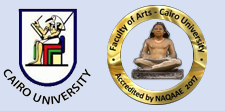عنوان المقال عربي
دور المتأثر ووظائفه النحوية دراسة تحويلية
Document Type
Book Review
Keywords English
Thematic roles, Patient role, grammatical functions, Verbal predicate, Nominalized predicate, argument structure, Theta Criterion
كلمات مفتاحية عربي
الأدوار الدلالية, دور المتأثر, المسند الفعلي, المسند المسمى, بنية المشارك, المعيار الدلالي
Abstract English
Transformationalists have started their works in linguistics based on the autonomy of syntax. However, they have used semantic relations in later stages of the development of transformational theory. For example, they have introduced thematic roles. The Agent, Patient, Experiencer, Goal, Locative and Instrument are examples of these roles. Semantically speaking, the sentence in Arabic is divided into two parts: the first is the predicate that indicates the event or activity; and the second is the number of Arguments such as the internal argument and external argument which contribute to the completion of the event of activity. They are syntactically represented by noun phrases that perform different functions and they carry thematic roles necessary for the semantic description. The Patient is the entity on which the action is executed, affected by, or causes its change. The perfect case for this role is when the internal argument bears it. However, it may be carried out by external arguments. The most important results of this study are: the perfect role of the Agent is done by the external argument, and the perfect role for the patient is to done by the internal argument. However, the external argument that functions as a subject may also be a Patient. This is related to two verbal patterns in Arabic. The first pattern is (Almusta’ra) verbs and the second is (mutawaa) verbs - literally (obedience) verbs. One of the results is that Arabic dictionaries mention verbs that indicate the meaning of sensory events like (afala) أفعل or (faala) فعّل or (faalala) فعلل, and , therefore, its external argument carries the patient role.
الملخص العربي
لقد بدأ التحويليون أعمالهم اللغوية بتبني مبدأ استقلال التراكيب، ولكنهم أدخلوا العلاقات الدلالية في مراحل لاحقة من تطور النظرية التحويلية، ومن هذه العلاقات التي أدخلوها إلى وصف الجمل وتفسيرها الأدوار الدلالية التي يحملها المشاركون في الحدث، ومن هذه الأدوار: الموجد والمتأثر، والمجتاز، والهدف، والمكان، والوسيلة. تُقَسَّمُ الجملة العربية في المستوى الدلالي إلى قسمين: أولهما: المسند الذي يدل على الحدث أو النشاط ويمثله تركيبيًّا الفعل أو ما يعمل عمل الفعل، وثانيهما: عدد من المشاركين Arguments في إتمام الحدث أو النشاط، مثل المشارك الخارجي والمشارك الداخلي. ويمثلهم تركيبيًّا المركبات الاسمية التي تقوم بالوظائف المختلفة. والمشاركون هم الذين يحملون الأدوار الدلالية اللازمة للوصف الدلالي. والمتأثر هو الكائن الذي ينفذ عليه الحدث أو يتأثر به أو يحركه أو تتغير حالته، والحالة المثلى لهذا الدور هي أن يحمله المشارك الداخلي. ولكن قد يحمله مشاركون خارجيون في الحدث مثل الفاعل ونائب الفاعل. ومن أهم النتائج التي توصل إليها البحث أن الدور الأمثل الذي يحمله المشارك الخارجي هو الموجد، والدور الأمثل الذي يحمله المشارك الداخلي هو المتأثر، ولكن المشارك الخارجي الذي يقع فاعلا قد يحمل دور المتأثر أيضا، ويرتبط ذلك في العربية بنمطين فعليين، أولهما: الأفعال المستعارة للاختصار، وثانيهما أبنية المطاوعة. ومن النتائج أن المعاجم العربية قد ذكرت مواد فعلية تدل على معاني العرض الحسي وقد عُبِّرَ عنها بصيغ فعلية متنوعة مثل (أفعل)، و(فعَّل) و(فَعْلَلَ) و(افعلَّ)، و(تَفَعَّلَ)، بالإضافة إلى (فَعَلَ)، و(فَعِلَ) وبالتالي يحمل مشاركها الخارجي دور المتأثر.
Recommended Citation
Morsy, Khaled Tokal
(2018)
"The Role of the Patient and its Grammatical Functions,"
Journal of the Faculty of Arts (JFA): Vol. 78:
Iss.
4, Article 9.
DOI: 10.21608/jarts.2018.83536
Available at:
https://jfa.cu.edu.eg/journal/vol78/iss4/9
Digital Object Identifier (DOI)
10.21608/jarts.2018.83536
Accept Date
2017-04-18
Publication Date
10-1-2018

